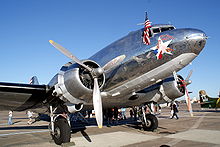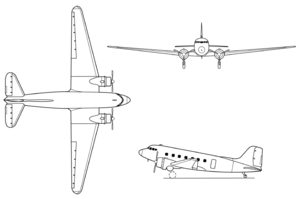- Douglas C-47 Skytrain
-
"C-47" redirects here. For other uses, see C47 (disambiguation).
C-47 Skytrain
C-53 SkytrooperRole Military transport aircraft National origin United States Manufacturer Douglas Aircraft Company Designer Douglas Aircraft First flight 23 December 1941[1] Primary users United States Army Air Forces
Royal Air Force
United States Navy
See operatorsNumber built >10,000 Developed from Douglas DC-3 Variants Douglas XCG-17
Douglas AC-47 SpookyThe Douglas C-47 Skytrain or Dakota is a military transport aircraft that was developed from the Douglas DC-3 airliner. It was used extensively by the Allies during World War II and remained in front line operations through the 1950s with a few remaining in operation to this day.
Contents
Design and development
The C-47 differed from the civilian DC-3 in numerous modifications that included being fitted with a cargo door and strengthened floor.[2]
During World War II, the armed forces of many countries used the C-47 and modified DC-3s for the transport of troops, cargo and wounded. The US Naval designation was R4D. Over 10,000 aircraft were produced in Long Beach and Santa Monica, California and Oklahoma City, Oklahoma. The Oklahoma City plant produced 5,354 C-47s from March 1943 until August 1945.
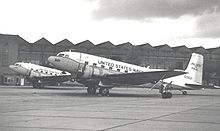 US Navy C-117Ds at RAF Mildenhall in 1967
US Navy C-117Ds at RAF Mildenhall in 1967
 Lawson Field, Ft. Benning, Georgia.
Lawson Field, Ft. Benning, Georgia.
Super DC-3 (R4D-8)
In response to proposed changes to the airworthiness requirements that would limit the continuing use of the large numbers of DC-3s and surplus C-47s in commercial use in the United States, Douglas offered a late 1940s conversion of the DC-3 modified to improve takeoff and single-engined performance to meet the new Civil Air Regulations, and with increased speed to compete with newer airliners. The new model, the DC-3S or "Super DC-3", was 39 in (0.99 m) longer, allowing 30 passengers to be carried. It also had larger tail surfaces and new outer wings with a greater sweep back at the trailing edge to accommodate a rearward shift in the center of gravity. More powerful engines, either 1,475 hp (1,100 kW) Wright R-1820 Cyclones or 2,000 hp (1,490 kW) Pratt & Whitney R-2000s incorporated into larger engine nacelles, were installed along with shorter, jet ejection-type exhaust stacks. Minor changes included wheel well doors and a partially retractable tail wheel along with flush rivets and low drag antennas, that all contributed to a top speed of 250 mph. With over 75% of the original DC-3/C-47 configuration changed, the modified design ended up virtually as a new aircraft.[3] The first DC-3S made its maiden flight on 23 June 1949.[4]
Although the changes fully met the new FAR 4B airworthiness requirements, and significantly improved performance, there was little interest from commercial operators in the DC-3S, which was too-expensive for the smaller operators who were its main target, with only three being sold to Capital Airlines. The US Navy, however, had 100 of its R4D aircraft modified to Super DC-3 standard as the R4D-8, these later being redesignated C-117D.[5]
Operational history
The C-47 was vital to the success of many Allied campaigns, in particular those at Guadalcanal and in the jungles of New Guinea and Burma where the C-47 (and its naval version, the R4D) made it possible for Allied troops to counter the mobility of the light-traveling Japanese army. Additionally, C-47s were used to airlift supplies to the embattled American forces during the Battle of Bastogne. But possibly its most influential role in military aviation was flying "The Hump" from India into China. The expertise gained flying "The Hump" would later be used in the Berlin Airlift, in which the C-47 would play a major role, until being replaced by the C-54.
In Europe, the C-47 and a specialized paratroop variant, the C-53 Skytrooper, were used in vast numbers in the later stages of the war, particularly to tow gliders and drop paratroops. In the Pacific, with careful use of the island landing strips of the Pacific Ocean, C-47s were even used for ferrying soldiers serving in the Pacific theater back to the United States.
C-47s in British and Commonwealth service took the name Dakota, from the acronym "DACoTA" for Douglas Aircraft Company Transport Aircraft.[6] The C-47 also earned the informal nickname Gooney Bird in the European theater of operations.[7]
The USAF Strategic Air Command had C-47 Skytrains in service from 1946 through 1967.
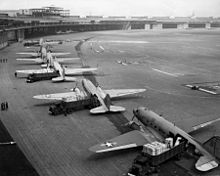 C-47s unloading at Tempelhof Airport during Berlin Airlift.
C-47s unloading at Tempelhof Airport during Berlin Airlift.
The Pakistan Air Force used C-47 Dakota cargo planes which it used to transport supplies to the Pakistan Army soldiers fighting in the Indo-Pakistan War of 1947 against India.
Several C-47 variations were used in the Vietnam War by the United States Air Force, including three advanced electronic warfare variations which were sometimes called "Electric Gooneys" designated EC-47N, EC-47P, or EC-47Qs depending on the engine used.[8] EC-47s were also operated by the Vietnamese, Laotian and Cambodian Air Forces.[9] A gunship variation, utilizing three 7.62mm miniguns, designated AC-47 "Spooky" often nicknamed "Puff the Magic Dragon" was also deployed.[7]
The Royal Canadian Air Force and later, the Canadian Armed Forces employed the C-47 for transportation, navigation and radar training, and search & rescue operations from the 1940s to the 1980s.[10]
After World War II thousands of surplus C-47s were converted to civil airline use, some remaining in operation in 2010.
Variants
 Aircraft of the 6th Special Operations Squadron including a C-47T in use by the US Air Force
Aircraft of the 6th Special Operations Squadron including a C-47T in use by the US Air Force
 An ex-USAAC C-47A Skytrain which was displayed at Cotswold Airport, Gloucestershire, England was recently purchased by Kermit Weeks and returned to the U.S. in August of 2011. This aircraft flew from a base in Devon, England, during the D-Day Normandy invasion and shows "invasion stripes" on the wings and fuselage.
An ex-USAAC C-47A Skytrain which was displayed at Cotswold Airport, Gloucestershire, England was recently purchased by Kermit Weeks and returned to the U.S. in August of 2011. This aircraft flew from a base in Devon, England, during the D-Day Normandy invasion and shows "invasion stripes" on the wings and fuselage.
- C-47
- Initial military version of the DC-3 with seats for 27 troops, 965 built including 12 to the United States Navy as R4D-1,
-
- C-47A
- C-47 with a 24-volt electrical system, 5,254 built including USN aircraft designated R4D-5.
- RC-47A
- C-47A equipped for photographic reconnaissance and ELINT missions.
- SC-47A
- C-47A equipped for Search Air Rescue; redesignated HC-47A in 1962.
- VC-47A
- C-47A equipped for VIP transport role.
- C-47B
- Powered by R-1830-90 engines with superchargers and extra fuel capacity to cover the China-Burma-India routes, 3,364 built.
- VC-47B
- C-47B equipped for VIP transport role.
- XC-47C
- C-47 tested with Edo Model 78 floats for possible use as a seaplane.[11][12]
- C-47D
- C-47B with superchargers removed after the war.
-
- EC-47D
- C-47D with equipment for the Airborne Early Warning role; prior to 1962 was designated AC-47D.
- NC-47D
- C-47D modified for test roles
- RC-47D
- C-47D equipped for photographic reconnaissance and ELINT missions.
- SC-47D
- C-47D equipped for Search Air Rescue; redesignated HC-47D in 1962.
- VC-47D
- C-47D equipped for VIP transport role.
- C-47E
- Modified cargo variant with space for 27–28 passengers or 18–24 litters.
-
- C-47F
- YC-129 re-designated, Super DC-3 prototype for evaluation by USAF later passed to USN as XR4D-8.
- C-47L/M
- C-47H/Js equipped for the support of American Legation United States Naval Attache (ALUSNA) and Military Assistance Advisory Group (MAAG) missions.
- EC-47N/P/Q
- C-47A and D aircraft modified for ELINT/ARDF mission. N and P differ in radio bands covered, while Q replaces analog equipment found on the N and P with a digital suite, redesigned antenna equipment and uprated engines.
- C-47R
- One C-47M modified for high altitude work, specifically for missions in Ecuador.
- C-47T
- Designation applied to aircraft modified to a Basler BT-67 standard.
- C-47TP Turbo Dakota
- Refit with modern turboprop engines and fuselage stretch for the South African Air Force.
- C-53 Skytrooper
- Troop transport version of the C-47.
-
- XC-53A Skytrooper
- One aircraft with full-span slotted flaps and hot-air leading edge deicing.
- C-53B Skytrooper
- Winterised version of C-53 with extra fuel capacity and separate navigator's station, eight built.
- C-53C Skytrooper
- C-53 with larger port-side door, 17 built.
- C-53D Skytrooper
- C-53C with 24V DC electrical system, 159 built.
- C-117A Skytrooper
- C-47B with 24-seat airline-type interior for staff transport use, 16 built.
-
- VC-117A
- Three redesignated C-117s used in the VIP role.
- SC-117A
- One C-117C converted for air-sea rescue.
- C-117B/VC-117B
- High-altitude superchargers removed, one built and conversions from C-117As all later VC-117B
- C-117D
- USN/USMC R4D-8 redesignated
- LC-117D
- USN/USMC R4D-8L redesignated
- TC-117D
- USN/USMC R4D-8T redesignated
- VC-117D
- USN R4D-8Z redesignated
- YC-129
- Super DC-3 prototype for evaluation by USAF redesignated C-47F and later passed to USN as XR4D-8.
- CC-129
- Canadian Forces designation for the C-47 (post-1970).
- XCG-17
- One C-47 tested as a 40-seat troop glider with engines removed and faired over.
- R4D-1 Skytrain
- USN/USMC version of the C-47.
-
- R4D-3
- Twenty C-53Cs transferred to USN.
- R4D-5
- C-47A variant 24-volt electrical system replacing the 12-volt of the C-47; redesignated C-47H in 1962, 238 transferred from USAF.
- R4D-5L
- R4D-5 for use in Antarctica. Redesignated LC-47H in 1962.
- R4D-5Q
- R4D-5 for use as special ECM trainer. Redesignated EC-47H in 1962.
- R4D-5R
- R4D-5 for use as a personnel transport for 21 passengers and as a trainer aircraft; redesignated TC-47H in 1962.
- R4D-5S
- R4D-5 for use as a special ASW trainer; redesignated SC-47H in 1962.
- R4D-5Z
- R4D-5 for use as a VIP transport; redesignated VC-47H in 1962.
- R4D-6
- 157 C-47Bs transferred to USN; redesignated C-47J in 1962.
- R4D-6L, Q, R, S, and Z
- Variants as the R4D-5 series; redesignated LC-47J, EC-47J, TC-47J, SC-47J, and VC-47J respectively in 1962.
- R4D-7
- 44 TC-47Bs transferred from USAF for use as a navigational trainer; redesignated TC-47K in 1962.
-
- R4D-8
- R4D-5 and R4D-6 aircraft fitted with modified wings and re-designed tail surfaces; redesignated C-117D in 1962.
- R4D-8L
- R4D-8 converted for Antarctic use, redesignated LC-117D in 1962.
- R4D-8T
- R4D-8 converted as crew trainers, redesignated TC-117D in 1962.
- R4D-8Z
- R4D-8 converted as a staff transport, redesignated VC-117D in 1962.
RAF designations
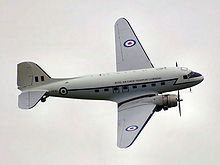 Royal Air Force's Dakota IV in RAF Transport Command colours, owned by the UK Air Atlantique Classic Flight
Royal Air Force's Dakota IV in RAF Transport Command colours, owned by the UK Air Atlantique Classic Flight
- Dakota I
- RAF designation for the C-47 and R4D-1
- Dakota III
- RAF designation for the C-47A.
- Dakota IV
- RAF designation for the C-47B.
Operators
See also: List of C-47 Skytrain operatorsPortuguese Air Force C-47A
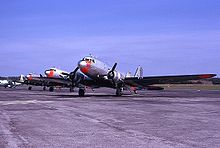 Swedish Air Force Tp 79 (C-47A)
Swedish Air Force Tp 79 (C-47A)
Accidents and incidents
Further information: List of accidents and incidents involving the DC-3Specifications (C-47B-DK)
Data from McDonnell Douglas Aircraft since 1920[14]
General characteristics
- Crew: 3
- Capacity: 28 troops
- Payload: 6,000 lb (2,700 kg)
- Length: 63 ft 9 in (19.43 m)
- Wingspan: 95 ft 6 in (29.41 m)
- Height: 17 ft 0 in (5.18 m)
- Wing area: 987 ft² (91.70 m²)
- Empty weight: 18,135 lb (8,226 kg)
- Loaded weight: 26,000 lb (11,793 kg)
- Max takeoff weight: 31,000 lb (14,061 kg)
- Powerplant: 2 × Pratt & Whitney R-1830-90C Twin Wasp 14-cylinder radial engines, 1,200 hp (895 kW) each
Performance
- Maximum speed: 224 mph (195 kn, 360 km/h) at 10,000 ft (3,050 m)
- Cruise speed: 160 mph (139 kn, 257 km/h)
- Range: 1,600 mi (1,391 nmi, 2,575 km)
- Ferry range: 3,600 mi (3,130 nmi, 5,795 km)
- Service ceiling: 26,400 ft (8,045 m)
- Climb to 10,000 ft (3,050 m): 9.5 min
See also
 Brigadier General Anthony C. McAuliffe, artillery commander of the 101st Airborne Division, talks to paratroopers on D-Day minus 1, behind can be seen a CG-4 Waco glider and C-47s.
Brigadier General Anthony C. McAuliffe, artillery commander of the 101st Airborne Division, talks to paratroopers on D-Day minus 1, behind can be seen a CG-4 Waco glider and C-47s.
- Related development
- Aircraft of comparable role, configuration and era
- Curtiss C-46 Commando
- Related lists
- List of military aircraft of the United States
- List of military aircraft of the United States (naval)
References
- Notes
- ^ "C-47 Skytrain." Boeing. Retrieved: 1 August 2010.
- ^ Wilson, Stewart. Aircraft of WWII. Fyshwick, ACT, Australia: Aerospace Publications Pty Ltd., 1998. ISBN 1-875671-35-8.
- ^ "Super DC-3." dc3history.org. Retrieved: 23 June 2010.
- ^ Francillon 1979, pp. 464–465.
- ^ Francillon 1979, pp. 466–467.
- ^ "History: Douglas C-47 Skytrain Military Transport." Boeing. Retrieved: 7 August 2008.
- ^ a b O'Rourke, G.G, CAPT USN. "Of Hosenoses, Stoofs, and Lefthanded Spads." United States Naval Institute Proceedings, July 1968.
- ^ "Chronological History of the EC-47's Location by Tail Number." ec47.com. Retrieved: 7 April 2009.
- ^ Rickard, J. "Douglas EC-47N." historyofwar.org, 12 November 2008. Retrieved: 7 April 2009.
- ^ "Douglas DC-3 (CC-129) Dakota." DND - Canada's Air Force. Retrieved: 14 October 2009.
- ^ "Aviation In Long Pants" (photo of XC-47C). Popular Mechanics, July 1944.
- ^ "DC-3s On Floats." Youtube, 8 November 2008, Note: first part has rare World War II film footage and narration by project manager for the XC-47C.
- ^ "Das Archiv der Deutschen Luftwaffe (in German)." LuftArchiv.de. Retrieved: 5 July 2010.
- ^ Francillon 1979, p. 261.
- Bibliography
- Donald, David. The Complete Encyclopedia of World Aircraft. New York: Barnes & Noble, 1997. ISBN 0-7607-0592-5.
- Flintham, Victor. Air Wars and Aircraft: A Detailed Record of Air Combat, 1945 to the Present. New York: Facts on File, 1990. ISBN 0-81602-356-5.
- Francillon, René J. McDonnell Douglas Aircraft Since 1920. London: Putnam & Company Ltd., 1979. ISBN 0-370-00050-1.
- Gradidge, Jennifer M. The Douglas DC-1, DC-2, DC-3 - The First Seventy Years (two volumes). Tonbridge, UK: Air-Britain (Historians) Ltd., 2006. ISBN 0-85130-332-3.
- Pearcy, Arthur Jr. "Douglas R4D variants (US Navy's DC-3/C-47)". Aircraft in Profile, Volume 14. Windsor, Berkshire, UK: Profile Publications Ltd., 1974, pp. 49–73. ISBN 0-35383-023-1.
- Yenne, Bill. McDonnell Douglas: A Tale of Two Giants. Greenwich, Connecticut: Bison Books, 1985. ISBN 0-517-44287-6.
External links
- Manual: (1943) T.O. No. 01-40NC-1 Pilot's Flight Operating Instructions C-47 Airplane
- The Assault Glider Trust
- Warbird Alley: C-47 page
- American Aeronautical Foundation, C-47B "Aluminum Mistress"
- The SNAFU Special C-47A aircraft recovered and restored
Douglas military aircraft Fighters Ground attack Naval bombers
and attack aircraftBombers Observation Patrol PD · P2D · P3D
Reconnaisance Transports C-1 · C-21 · C-32 · C-33 · YC-34 · C-38 · C-39 · C-41 · C-41A · C-42 · C-47 · C-48 · C-49 · C-50 · C-51 · C-52 · C-53 · C-54 · C-58 · UC-67 · C-68 · C-74 · C-84 · C-110 · XC-112/YC-112 · XC-114 · YC-116 · C-117 · C-118 · C-124 · YC-129 · C-133 · XCG-17
C-9 · C-24
RD · R2D · R3D · R4D (R4D-2 & R4D-4) · R5D · JD · R6D
CC-129 · Dakota I/III/IV · Dakota II · LXD1 · PD.808 · Skymaster ITraining aircraft Experimental Designation sequences for this aircraft: USAAS/USAAC/USAAF/USAF transport designations 1925–1962, 2005-2006 Main sequence
1925-1962C-1 • C-2 • C-3 • C-4 • C-5 • C-6 • C-7 • C-8 • C-9 • XC-10 • Y1C-11 • Y1C-12 • C-13 (Not assigned) • C-14 • C-15 • C-16 • Y1C-17 • C-18 • C-19 • C-20 • C-21 • Y1C-22 • Y1C-23 • Y1C-24 • Y1C-25 • C-26 • C-27 • C-28 • C-29 • YC-30 • C-31 • C-32 • C-33 • C-34 • XC-35 • C-36 • C-37 • C-38 • C-39 • C-40 • C-41/A • C-42 • UC-43 • C-44 • C-45 • C-46 • C-47 • C-48 • C-49 • C-50 • C-51 • C-52 • C-53 • C-54 • C-55 • C-56 • C-57 • C-58 • C-59 • C-60 • UC-61 • C-62 • C-63 • C-64 • C-65 • C-66 • UC-67 • C-68 • C-69 • UC-70/A/B/C/D • UC-71 • UC-72 • C-73 • C-74 • C-75 • C-76 • UC-77 • C-78 • C-79 • C-80 • UC-81 • C-82 • C-83 • C-84 • UC-85 • C-86 • C-87 • C-88 • C-89 • C-90 • C-91 • UC-92 • C-93 • UC-94 • UC-95 • UC-96 • KC-/C-97 • C-98 • XC-99 • UC-100 • UC-101 • C-102 • UC-103 • C-104 • C-105 • C-106 • C-107 • C-108 • C-109 • C-110 • C-111 • XC-112 • XC-113 • XC-114 • XC-115 • XC-116 • C-117 • C-118 • C-119 • XC-120 • C-121/F • YC-122 • C-123/A • C-124 • YC-125 • LC-126 • C-127 (I) • C-127 (II) • C-128 • YC-129 • C-130 • C-131 • C-132 • C-133 • YC-134 • KC-/C-135 • C-136 • C-137 • C-138 (Not assigned) • C-139 (Not assigned) • C-140 • C-141 • XC-142
Revived sequence
2005-2006C-143 • C-144
See also: Post-1962 listUS Navy/US Marine Corps transport designations 1931-1962 Atlantic Aircraft Buhl Curtiss Douglas Bellanca Kinner Martin Lockheed Stinson Fairchild Ford Sikorsky RSNorthrop Lockheed R6V • R7V/R7V-2 • R8V
Convair Swedish Air Force military aircraft designations 1940–present B/S/T/Tp 16 - Sk 16 • B/S 17 • B/S/T 18 • J 19 • J 20 • A/J 21 • J/S 22 • J 23 • B/J 24 - Tp 24 • Sk 25 • Sk 26 - B/S 26 - J/S 26 • J 27 • A/J/Sk 28 • A/J/S 29 • J 30 • S 31 • A/J/S 32 • J 33 • J 34 • J/S/Sk 35 • A 36 • AJ/JA 37 • A/Sk 38 • JAS 39 • Tp 45 • Tp 46 • Tp 47 • Sk 50 • Fpl 51 • Tp 52 • Tp 53 • Fpl 54 - Tp 54 • Tp 55 • Sk 60 • Sk/Fpl 61 • Tp 78 • Tp 79 • Tp 80 • Tp 81 • Tp 82 • Tp 83 • Tp 84 • Tp 85 • Tp 86 • Tp 87 • Tp 88 • Tp 89 • Tp 91 • Tp 100 • Tp 101 • Tp 102 • Tp 103
Canadian Forces unified aircraft designations post-1968 100-125 126–150 151- Lists relating to aviation General Aircraft (manufacturers) · Aircraft engines (manufacturers) · Airlines (defunct) · Airports · Civil authorities · Museums · Registration prefixes · Rotorcraft (manufacturers) · TimelineMilitary Accidents/incidents Records Categories:- Douglas aircraft
- Military aircraft of the Korean War
- United States military transport aircraft 1940–1949
- Military aircraft of the Vietnam War
- World War II transport aircraft of the United States
Wikimedia Foundation. 2010.





